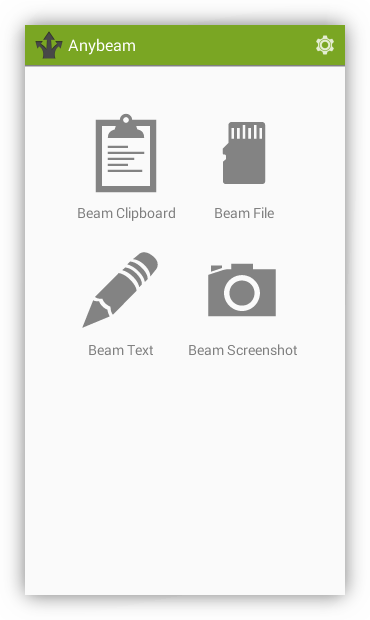Overview
Anybeam was created with the goal to make the transmission of data as easy and simple as possible. But still there can be some problems with using our application. That's why we made this little page to help you with eventual starting problems.
If you still can't get our application to work, have a good suggestion for an enhancement or just want to say how much you love Anybeam, you can email us. You find the address on our about site.
Devices & Systems
 Android 4+
Android 4+ Windows 7,8 or 8.1
Windows 7,8 or 8.1 Mac OSx
Mac OSx Ubuntu 12.04+
Ubuntu 12.04+ Java 7+
Java 7+
If you want Anybeam on your Android device, simply download it from the Google Play Store.
For the desktop environment you need to have at least Java 7 installed!
For an advanced installation guide see the Installation chapter.
Connecting
First make sure that your group settings (Group Password, Broadcast Port and Encryption Type) are equal on all your devices.
And have Anybeam running on each device you want to send or receive data from.
Android
On Android it is very simple, just use the share function you can find in many other applications. You will see that you can share most of your data.
After you have opened Anybeam on your Android device, select your target from the list of devices with running Anybeam.
If you don't want to share any files you can either send text using the Android share function or share your clipboard content by opening the Anybeam application.


Desktop
For your desktop environment start Anybeam, which is located in your task bar, and select what kind of data you want to send.
There are four different options available. You can choose between sending your current clipboard text, a file from your hard drive, input text or capture and send a screenshot


Troubleshooting
Q: I can't find my Android device!
A: Make sure that the display of your Android device is on. If this won't work try the next answer.
Q: I can't find any device!
A: First make sure that all your group settings (Group Password, Broadcast Port and Encryption Type) are equal on all your devices.
Then you have to connect each device you want to use to the same local network.
Anybeam is relying on broadcast packages to find the other device automatically.
Note that in some larger networks (school or office) Anybeam may not work because
each device is connected to different access points and broadcast packages won't be transmitted between them.
Q: I still can't find any device!
A: Sometimes it helps to reopen the Android application, in case the Android system has shut down the background search mechanism.
Q: I can find the device but can't send to the target device.
A: Make sure that all your group settings (Group Password, Broadcast Port and Encryption Type) are equal on all your devices.
Q: I have some other problem or found a bug.
A: Just write us an email with an detailed description of what the problem or bug is.
You will find the address on our about site
API
Did you know the core library and API for Anybeam is available under the GNU GPLv2 on Github? We made this part available so you are able to fork our project and develop your own extensions or search for bugs.
Desktop
Installation
Windows
- Download and install the latest Java 7 version.
- Download Anybeam
- Launch Anybeam by opening the Anybeam.exe file.
Mac OS
Needs Attention!Ubuntu
- Search and install 'Java 7' from the Ubuntu software center
or open a terminal console and input 'sudo apt-get install openjdk-7-jre' - Download Anybeam
- Make sure that the execute permission in the Anybeam.jar properties is set
or open a terminal console navigate to the Anybeam.jar and execute the following command: 'chmod +x Anybeam.jar' - Launch Anybeam with OpenJDK Java 7 Runtime
Autostart
Windows
- Select the Autostart option in the application preference.
Mac OS
Needs Attention!Ubuntu
- Create a shell script with the following content:
anybeam.sh
#!/bin/bash
java -jar path/to/jar/Anybeam.jar
exit 0 - Open a terminal console and set the permissions for the shell script with 'chmod 700 /path/to/script/anybeam.sh'
- Open Session properties
or open a terminal console and input 'gnome-session-properties' - Add a new entry with the following properties: name="Anybeam" and command="/path/to/script/anybeam.sh"


